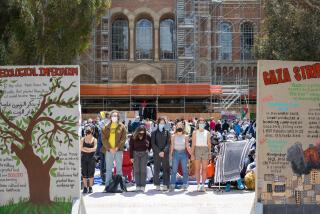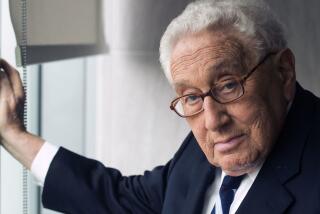Administration Insiders Stick Together in February Group
- Share via
A few months after he resigned, Richard M. Nixon pondered the fate of the hundreds of former White House employees who shared his dreams, fought his battles and were then left in the lurch by Watergate.
Some of them had trouble finding new jobs, having been tainted by the scandal. And many shared an experience from inside the White House that could not really be understood by an outsider.
“For a long time, those of us who had these connections were pariahs,” recalled Ken Khachigian, who began his lauded presidential speech-writing career with Nixon. “So you found comfort and solace in being amongst your own.”
In January, 1975, Nixon met in San Clemente with a former presidential advance man and suggested that he keep in touch with the former White House staffers. The following month, Dewey Clower called together 25 of them and launched the February Group, named after the month in which its first meeting was held.
Tonight--15 years later--the February Group is scheduled to host one of the largest gatherings of Nixon Administration alumni since Watergate. Nixon himself is expected to attend the cocktail reception at his presidential library in Yorba Linda on the eve of its dedication.
Add all of the longtime Nixon supporters and family scheduled to attend Thursday’s dedication, and “it will probably be the real first and last conclave of those who have been associated with Richard Nixon . . . since his second inaugural,” said Patrick J. Buchanan, a conservative political commentator and former Nixon speech writer.
In Washington, where job security is often an oxymoron, an alumni association for a presidential administration makes sense. But surprisingly, it is the Nixon White House that has created the largest and most active such group.
From the 25 members who organized on Feb. 10, 1975, the group has grown to include a mailing list of more than 600, including many members of the Ford and Reagan administrations.
In fact, when Ronald Reagan won the presidency in 1980, Clower said, the White House used the February Group mailing list to locate potential staff. And the group became big enough that columnist Jack Anderson once called it a “government in exile.”
Today, the February Group meets twice a year, usually for an evening of socializing over cocktails with about 100 to 150 people at a Washington hotel.
The February Group is essentially dedicated to maintaining a network that Nixon established as early as his 1968 presidential campaign. To do that, it hosts the cocktail hours, and from a desktop computer, Clower publishes a periodic newsletter with updates on the lives of group members.
Clower gladly points out what the group is not--it does not have a political agenda, it is not for fund raising and it is not even well-organized, he says.
“It’s a loose-knit organization: no dues, no officers,” Clower said. “It’s basically just a time for people to get together; it’s who is where, who has had babies, who got married, who has a new job.”
Most of the members, especially those who remain active, are middle-level Nixon White House staffers whose names never reached the newspapers. The former President’s favorite barber, Milt Pitts, is among them.
But Nixon’s top officers and Cabinet members are also on the February Group rolls. Former chief of staff H.R. Haldeman belongs, as does appointments secretary Dwight Chapin and aide John Erlichman.
“It’s for people who worked together and have stayed in touch or have a chance to renew friendships,” said Ron Ziegler, Nixon’s press secretary and a group member. “I think almost everyone who served in those years is on the (mailing) list.”
Erlichman, now a novelist who lives in Santa Fe, N.M., reportedly sent a letter to one February Group gathering that said: “Sorry I can’t be there. I’ll be doing something elsewhere.” He was in jail at the time in connection with Watergate.
Watergate may have been partly responsible for the cohesion of the former Nixon employees--at least at first. But Clower also said the Nixon White House was simply a tighter group than most.
“I worked briefly in the Ford Administration and I think the Nixon people were closer together,” Clower said. “I think the times probably had something to do with it. It is well known that a lot of people had difficulty finding jobs, and perhaps things like that draw people together.
“There are times when I just want to drop this (February Group activity), but then people call up and they really want to keep it going.”
Khachigian also said the camaraderie among Nixon’s staff is unique.
“The February Group is the Nixon guys who, sort of out the ashes of his resignation, said, ‘Hey, we ain’t down, let’s stick together.’ ” he said. “I call it a sort of gathering of the clan. There’s a lot of war stories to be told.”
As for the future of the February Group, Clower said he’s uncertain whether it will dissolve with the aging of the Nixon staff or whether it will evolve into something bigger.
“Maybe it will continue,” he said. “It really has become a group for Republican administrations.”
Who’s Coming . . .
Patrick J. Buchanan Then: White House speech writer. Now: Syndicated columnist and television commentator in Washington. Alexander M. Haig Then: White House Chief of staff. Now: Served as secretary of state early in Reagan Administration and was a 1988 presidential candidate. Presently runs international marketing firm and lectures. H.R. Haldeman Then: White House chief of staff; convicted of conspiracy, obstruction of justice and three counts of perjury related to Watergate. Imprisoned for 18 months. Now: Partner in an Orange County-based project to build an American-owned hotel in Moscow. Henry A. Kissinger Then: Secretary of state. Now: Author, syndicated columnist and lecturer. George P. Shultz Then: Secretary of labor. Now: Served as secretary of state in Reagan Administration and is now a fellow with the Hoover Institution at Stanford. William E. Simon Then: Secretary of the treasury. Now: Chairman of an investment banking company in New Jersey. Maurice Stans Then: Secretary of commerce and 1972 finance chairman of the Committee to Re-elect the President. Pleaded guilty to violating elections law and accepting illegal campaign contributions. Fined $5,000. Now: An accountant in Pasadena. Ron Ziegler Then: Press secretary Now: Executive director of the National Assn. of Chain Drug Stores in Washington. . . . Who’s Not Spiro T. Agnew Then: Vice president, who resigned Oct. 10, 1973, amid allegations of accepting contractor bribes for state work when he was governor of Maryland. Agnew pleaded no contest to charges of evading federal income taxes on the alleged bribes and made restitution of nearly $270,000 to the state of Maryland. Now: Lives in Rancho Mirage and works as a consultant for Middle East oil producers. Charles Colson Then: White House aide; pleaded guilty to one count of obstruction of justice in connection with a break-in at the office of Dr. Lewis J. Fielding, Daniel Ellsberg’s psychiatrist. Imprisoned for 18 months. Now: official of a prison Christian ministry group. John F. Dean Then: White House counsel; pleaded guilty to one count of obstruction of justice in connection with the Watergate cover-up. Imprisoned for about four months. Now: An investment banker living in Beverly Hills. John Ehrlichman Then: Domestic adviser to Nixon. Convicted of conspiracy, obstruction of justice and two counts of making false statements to a grand jury in connection with the Watergate cover-up. Convicted of conspiracy to violate civil rights and three counts of making a false statement to a grand jury in connection with the Fielding break-in. Imprisoned for 18 months. Now: A novelist and artist in Santa Fe., N.M. E. Howard Hunt Then: White House consultant; pleaded guilty to conspiracy, burglary and wiretapping. Imprisoned for 33 months. Now: Author of thriller and spy novels. G. Gordon Liddy Then: White House aide, counsel to Nixon re-election committee. Convicted of conspiracy to violate civil rights in connection with the Fielding break-in. Convicted of refusing to testify before a congressional committee. Convicted of conspiracy, burglary and wiretapping in connection with break-ins. Imprisoned for 52 months. Now: Lecturer, author and actor. John Mitchell Then: Attorney general; convicted of conspiracy, obstruction of justice, two counts of making false statements to a grand jury, one count of perjury. Imprisoned for 19 months. Now: Worked as a think-tank consultant after his release from prison and died of heart attack in 1988 at age 75. James W. McCord Then: Security coordinator of the Committee to Reelect the President; convicted of conspiracy, burglary and wiretapping. Imprisoned for about two months. Now: Fuel company executive in Colorado. Compiled by Times researcher Danny Sullivan and librarian Mary K. Lewis
More to Read
Get the L.A. Times Politics newsletter
Deeply reported insights into legislation, politics and policy from Sacramento, Washington and beyond. In your inbox twice per week.
You may occasionally receive promotional content from the Los Angeles Times.









